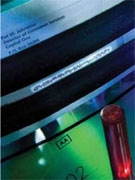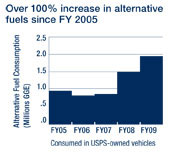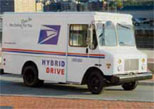We have a big job, delivering the mail to more than 150 million addresses in every community in America. We want to contribute to creating and maintaining a better, more sustainable environment in every one of them. — Postmaster General Jack Potter
Sustainability in Operations
Engineering for Sustainability

David Williams
Vice President,
Engineering
What’s New
- Two hydrogen fuel cell delivery vehicles have reached a milestone — more than 1 million pieces of mail delivered.
- Began testing secondary bypass oil filter in large trucks to reduce oil change frequency.
We built our business on technological innovation and adaptation. As the nation is changing, so are we. In the digital era, mail still plays a vital role.
Intelligent Mail
The launch of our Intelligent Mail services marked a milestone in our use of barcode technology by enabling business customers to track the status of their mail as soon as it enters the mailstream.

That means they can provide better service to their customers. And the Postal Service gets important operational data to allow for mail service measurement to help us improve service.
Alternate fuels
USPS has a rich tradition of exploring new methods of transportation to deliver the mail. Currently, we’re using a number of alternative fuel–capable vehicles on a variety of routes across the county.
Monitoring the maintenance and fuel consumption of many of these vehicles is the responsibility of our Engineering Department.
In Florida, California and Arizona, the Postal Service is testing the T-3 three-wheeled electric vehicle. The T-3 has a range of 40 miles, a maximum speed of 12 mph and can carry up to 450 pounds of mail. It has zero direct emissions and averages just over 2 cents a mile in energy costs.
In New York City, USPS has had 30 electric 2-ton vehicles on the street since 2001. Two 2-ton hybrid electric vehicles recently joined the postal fleet in Long Island, NY.
Washington, DC, and Irvine, CA, are each home to one of the new Chevy Equinox hydrogen fuel cell vehicles. Hydrogen fuel cells have zero direct emissions, other than water vapor.

The Postal Service also has upgraded more than 100 compressed natural gas (CNG) vehicles to operate in Texas. Greenhouse gas emissions are reduced by at least 40 percent in CNG vehicles compared to gasoline vehicles. The cost of CNG fuel in Texas is about $1 a gallon. The CNG upgrades will pay for themselves in a year through lower fuel costs.
We’re also taking a look at adding more electric delivery vehicles to our fleet. Toward that end, Engineering is working with potential suppliers on prototypes to convert five of our existing long-life vehicles to run on electricity.
Engineering also is testing a secondary bypass oil filter in our large trucks that will reduce the frequency of oil changes — saving us money and lowering our environmental impact.
Facts and Figures
2¢
cost per mile
to operate T-3 three-wheeled electric delivery vehicles
$70
million
saved by updating decommissioned machinery to avoid manual distribution
100
compressed
natural gas
vehicles upgraded to operate in Texas
Using machinery better
We continue to work with our suppliers to design the most cost- and energyefficient mail processing systems, both for new equipment as well as major retrofits.
We’ve been studying power consumption and exploring technology to reduce fuel used by existing equipment.
We also know that the most effective way to reduce energy costs is to improve how we use our machinery and remove systems that we don’t need from service. And we continually evaluate equipment requirements to make sure that run times match workloads.
To preserve gains in efficiency, maintenance programs are designed to make sure equipment runs at peak performance.
From the cover

“Reduce, Reuse and Recycle” are the watch words of USPS Sustainability. We’re reducing our use of petroleum-based fuels with alternative fuel vehicles like the hybrid drive delivery vehicle shown here.

We’re reusing decommissioned machinery like our carrier sequence bar code sorter to help keep mail in the automation mailstream. See the article “Back to the future” on this page for an example of one of the ways we’re encouraging customers to recycle.
Flats Sequencing System
We continue to roll out the Flats Sequencing System, which is revolutionizing the way we process flat-size mail, such as magazines and catalogs. The system enables us to sort mail in the order in which it’s delivered to customers.
This new technology is delivering high-impact efficiency, improving mail processing and making sure customers get more value from the mail.
Back to the future

When the Postal Service needed a way to return rejected mailpieces to the automated mailstream, it had two choices.
It could create new machines from the ground up at a cost of nearly $400,000 each, or retrofit decommissioned machinery to do the job.
USPS chose the green solution, updating nearly 190 carrier sequence barcode sorters to provide real-time information on mailpieces that had unreadable barcodes so they could be sorted on the fly.
The team responsible for breathing new life into the machines — and saving USPS millions of dollars — included Technology Development and Application Manager Brent Raney, Engineering Software Management Manager Mike Amato, Electronics Engineer Jerry Pender and Software Engineer Bill Storey.
Pender and Storey’s innovative approach — using existing technology — helped the Postal Service avoid higher costs of manually handling each piece of illegibly barcoded letter mail.
It’s estimated that USPS saved $70 million thanks to the team’s efforts.
